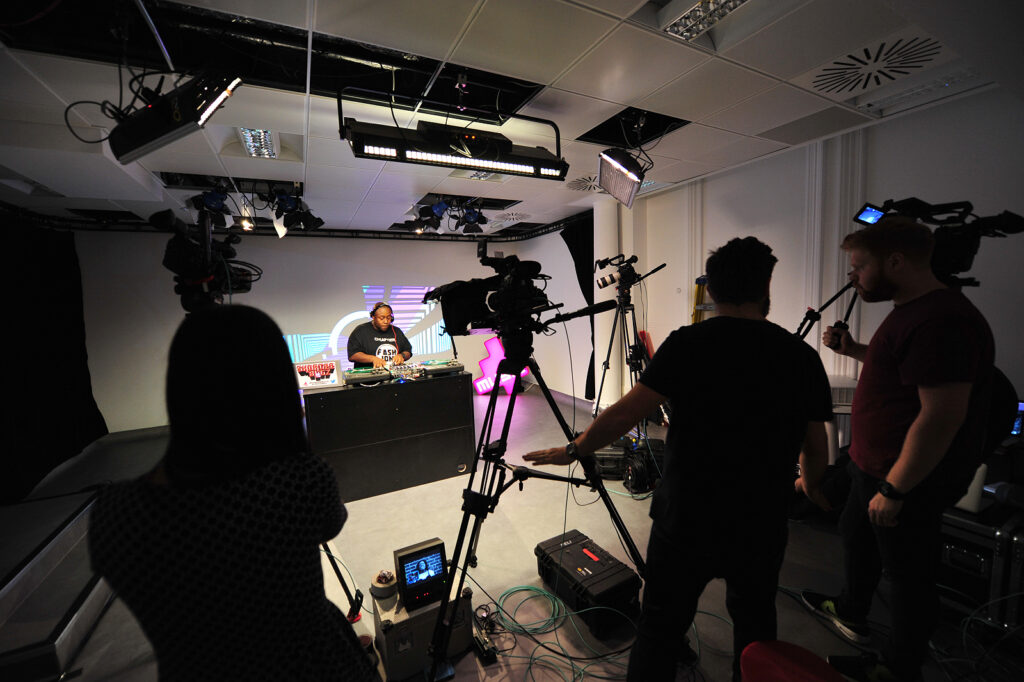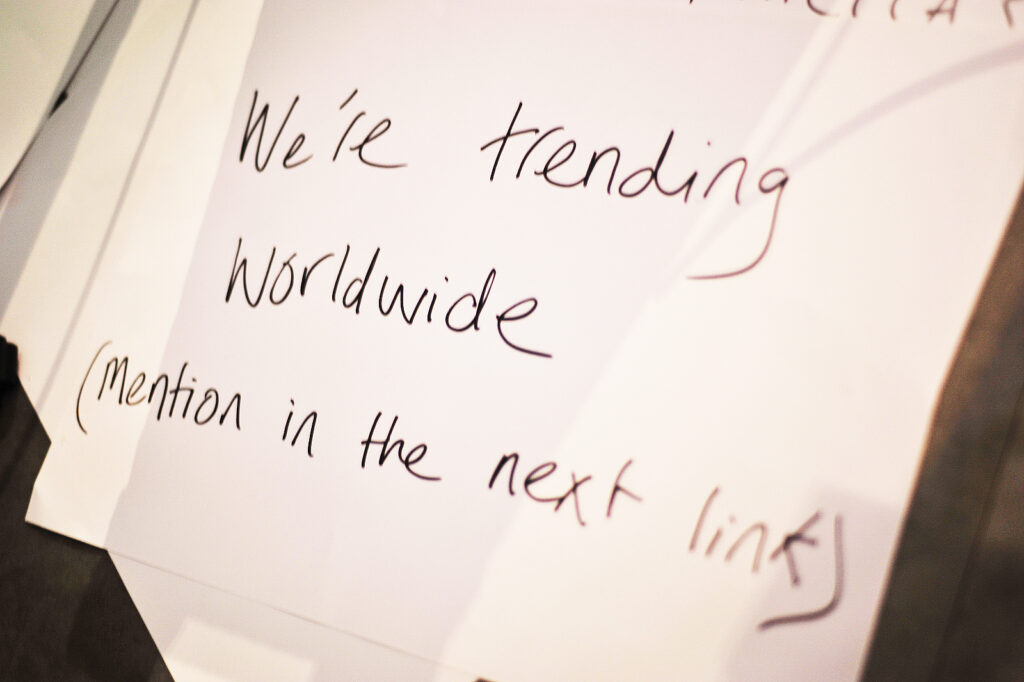Last week when looking at ITV’s annual report I suggested that News could be an opportunity for them based on what I perceived to be a relatively insular (ITVX focussed) strategy..
It got me thinking about how much of a greenfield opportunity Digital News is on new digital and social platforms. So I’ve spent the last week or so looking at the various iterations of legacy news operations and how they’ve been applied on these platforms. This all in advance of Ofcom‘s new News Consumption Survey which is due next month (May).
Some headlines…
- As it stands, The Daily Mail has the most effective overall social digital media strategy, although it feels quite disjointed and leads to a confusing brand picture.
- I find BBC News’s performance particularly lacklustre given their position as the UK’s number 1 media brand and the global influence they aspire to exert.
- The philosophical approach by our PSBs and some legacy media risks ceding control of the social news agenda to new entrants (GB News) whilst it’s importance continues to grow.
- There’s a significant upside opportunity for mainstream news brands to engage an already huge and growing audience.
YouTube
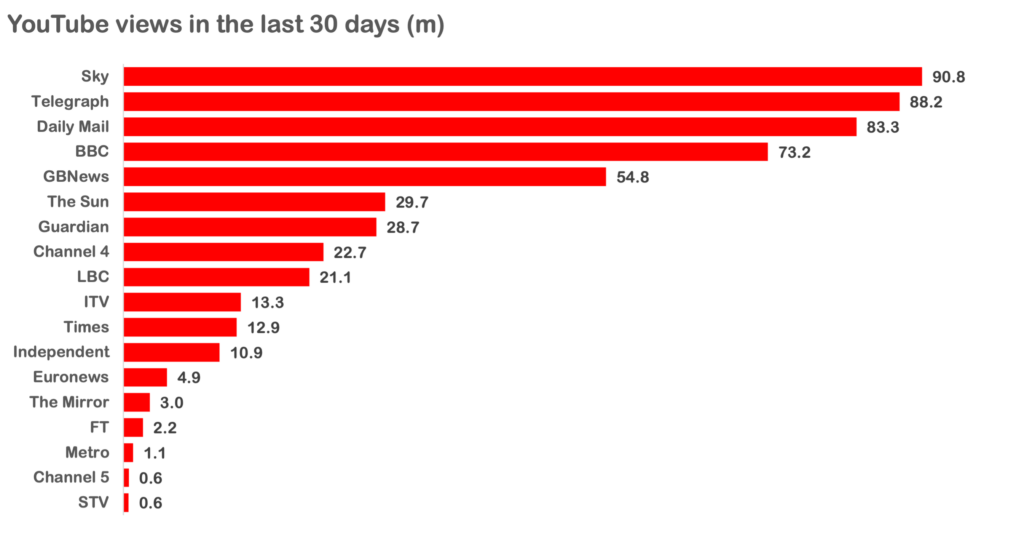
On YouTube, brands tended to follow one of two paths. Of the top performers, Sky News, BBC News and GB News employ an approach faithful to their overall editorial. Whereas the Telegraph’s and Daily Mail’s YouTube channels seem to bear little resemblance to any cohesive editorial strategy. That’s not to say they’re not engaging, but I struggle to see how generic syndicated news clips deliver any real value to their brand.
Sky was most impactful, delivering a high volume of content, including live-streams of their linear output, although I still feel there’s a HUGE opportunity in creating bespoke platform specific content tailored for this audience rather than simply clipping traditional linear output. We always found there was huge upside in leveraging the intelligence from usage data to optimise content with the specific platforms and audiences in mind. The BBC has some nice bespoke content on their ‘Shorts’ page but generally just post clipped content from their linear feed.
Overall, I found GB News’ approach to be the most adapted to the platform with a specific thumbnail strategy, some bespoke content, super high volume and use of live and a extremely faithful editorial output (if somewhat predictable and click-baity).
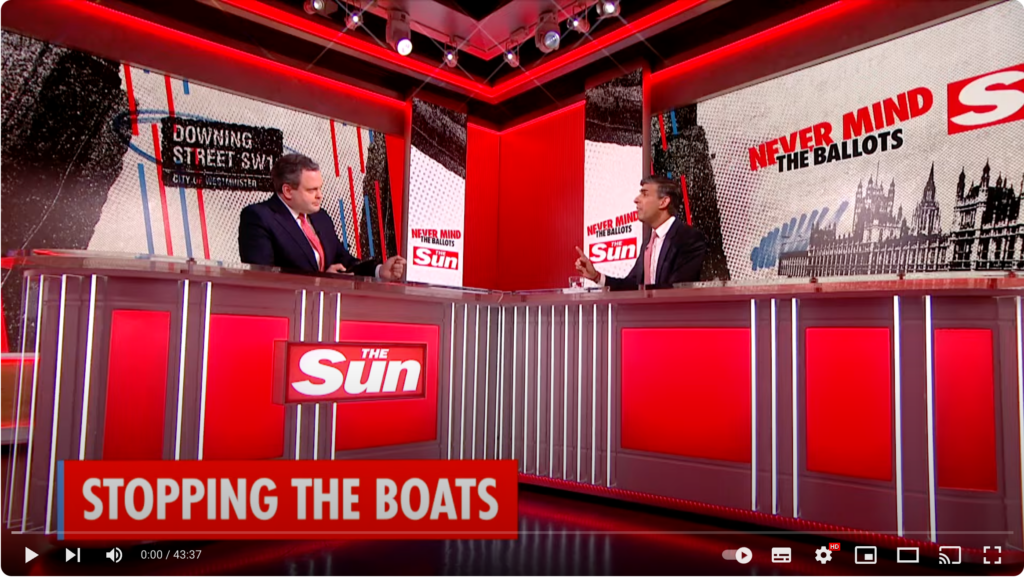
The Sun has built some bespoke content although rather than lean into audience and platform specific trends, they’ve taken a very traditional / formal ‘suits behind a desk’ approach presenting an audio visual case study of why you shouldn’t allow marketing or brand people to design sets.
Overall I find the YouTube numbers underwhelming. Despite the BBC being one of the best known English language news services in the world and allegedly being the most visited English language website, it’s only 197th in Social Blades list of YouTube’s impactful news channels (only 6 of the legacy UK services I reviewed appear at all in the top 500!). With the amount of content and resources at their disposal the BBC should be aiming north of 500m monthly views and could probably get closer to 1Bn.
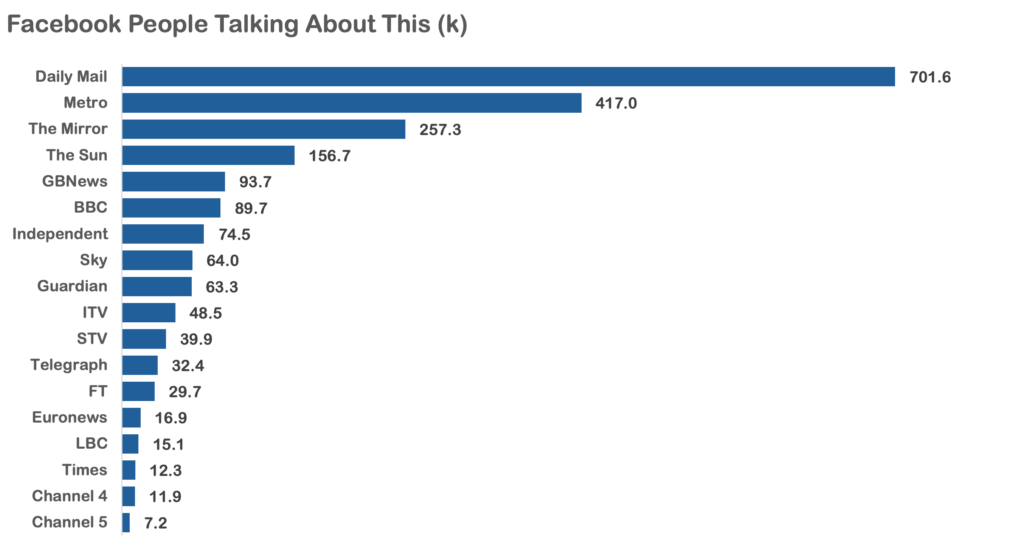
On Facebook I used their ‘People Talking About This’ stat as a comparative measure of currency and impact. Almost exclusively, News brands are using Facebook as a discussion board and link farm to drive people back to their owned websites and apps.
The Daily Mail are stand out leaders with a strategy of ridiculously high post volume (close to 10 every hour). Unlike their YouTube, it’s really faithful to their core digital editorial output and given the tabloid nature of the content, seems to generate a fair amount of discussion amongst the Facebook-crowd. Perhaps unsurprisingly, other tabloid titles dominate the top performers with all employing a slightly less effective version of the Mail’s strategy.

I personally struggle to recognise Instagram’s suitability as a viable news platform, but it’s mass media scale dictates audiences will consume it there regardless. The stats are difficult to interpret and the strategies quite unique. My analysis was centered around the main pages for legacy brands although brands (e.g. BBC News) often employ tens of different Insta accounts, a varying mix of images and reels, some video focused, whilst others clearly using picture editors to focus on image quality. I’ve considered multiple benchmarks.
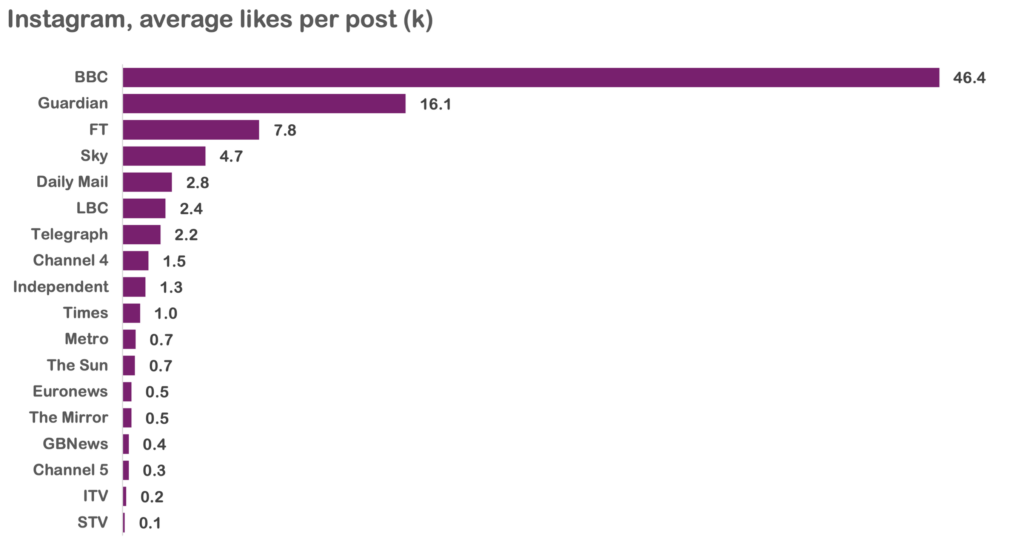
BBC News is the stand out leader with a massive 27m followers, 320k incremental followers within the last 30 days and 46.4k avg. likes per post. The Guardian and FT have impactful strategies leaning into the aesthetical nature of the platform. They have large follower numbers (5.8m & 3.4m) and are gaining large amounts of likes per post (16.1k and 7.8k) but they’re not posting very much (maybe once a day) and so any follower movement in the last 30 days is muted. Sky have a mixed picture editor / video strategy, are quite active in posting and generating significant engagement (likes per post) evident not only large in total follower numbers (1.9m) but also in terms of last 30 day movement (116k). GB News’ data is broken (via Social Blade) for the last 30 days and massively overstates their recent impact, they have 193k followers who aren’t particularly engaged (400 likes per post). Whilst extremely active, they’re basically using it as a video distribution platform.
I quite like what ITV and the Metro are doing. ITV has bespoke content (via Reels), although I’d like to see them fully adapt and replace the clipped linear content on the main feed. Metro have also developed quite a nice style leaning into platform functionality to mix the use of images, text and video quite effectively. Both strategies seem to be working with decent follower movement in the last 30 days.
TikTok
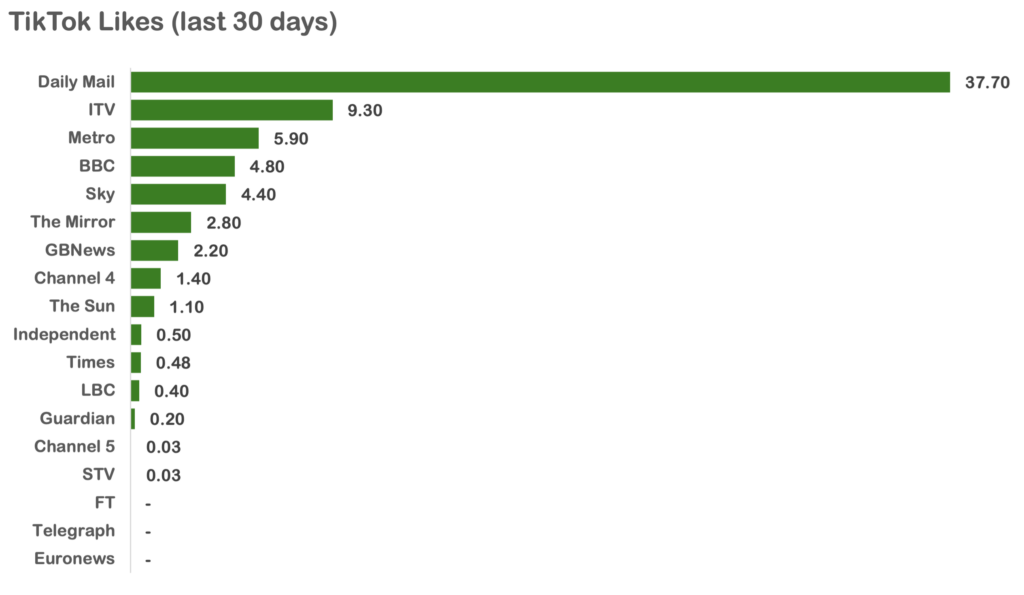
The Daily Mail has the largest and most engaged base on TikTok, but again has a unique editorial for this individual platform (this time a US-centric celebrity gossip focus). I’m sure there must be logic in their overarching strategy (they won’t cannibalise each other?) but it doesn’t feel additive to a consistent brand message from where I’m sat. You can’t deny they’ve achieved success and scale, although I note their digital revenues seemed to have flatlined last year and it will be interesting to see how they react to this. ITV are posting some of the bespoke content seen on their Insta, but again I’d like to see them take a wholly bespoke approach, engaging the audiences they’ve started to build. Metro are also making bespoke content but have a much lighter posting schedule, delivering the same impact (in likes) with only 10% – 20% (2/3 post per day) of the content output of the Mail, ITV, Sky or the BBC. BBC and Sky are still largely just clipping linear content albeit with some light post-production customisation and would do well to experiment with more bespoke content.
Owned platforms vs Social Media
Many of the PSBs and legacy news brands opt to favour their own platforms as a focus for their digital efforts based on an ability to own the data and/or monetise them more effectively (and not share any of that revenue). Whilst I can understand that, I don’t believe the PSBs do news entirely for commercial reasons and certainly I find the BBC’s philosophical approach here slightly odd given they don’t have the same commercial restrictions. All that said, I don’t believe social content particularly cannibalises other consumption and so would recommend a more active and innovative strategy to engage this growing audience. In fact, when you have a cohort of the population growing up away from traditional media channels, active social content strategies could be an important route to seed and build relationships between consumers and legacy brands that blossom into deeper direct consumption relationships further down the road.
Methodology
I looked at various legacy broadcast and publishing news services across YouTube, Facebook, Instagram and TikTok using Social Blade for my analysis trying to get reasonable metrics to assess currency and engagement. I pulled the data on the 3rd and 4th of April and so depending on lag of data feeds by platform the 30 day periods reviewed were consistent for comparative purposes and generally had most of March and possibly a few days of February. I reviewed The Independent, The Guardian, The Telegraph, Financial Times, Daily Mail, The Times, The Sun, BBC News, Channel 4 News, Channel 5 News, ITV News, Sky News, STV Group plc News, Euronews , Daily Mirror, Metro.co.uk, Global‘s LBC and GB News. To be clear, I’ve just been looking at the presentation of these services, not passing judgement on the status or quality of their journalism, nor have I tried to take a position on the bias of their output. I now need to go and purge my browsing history so I can get back to being fed golf clips rather than the various iterations of news the algorithms now think I’m interested in!

